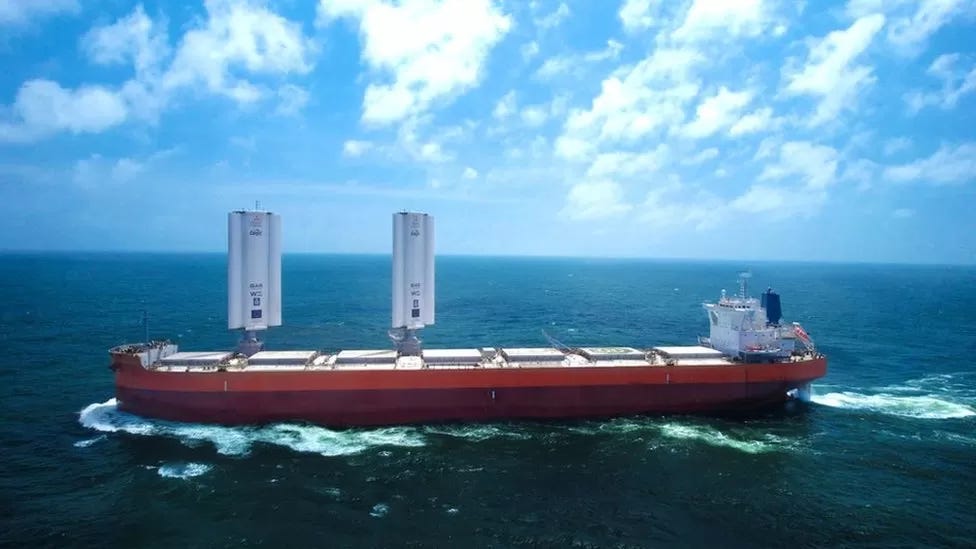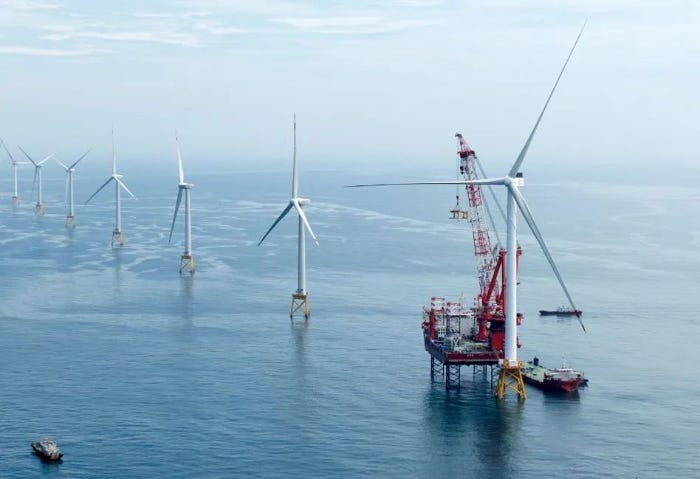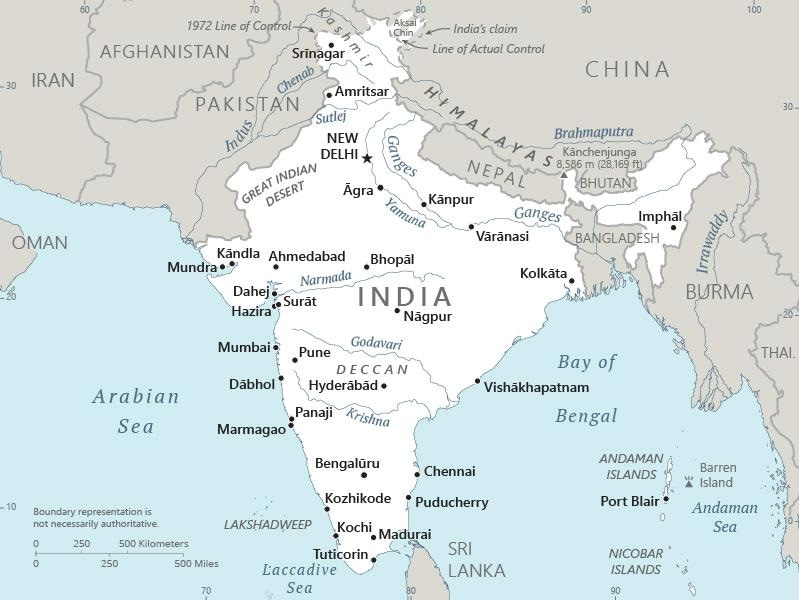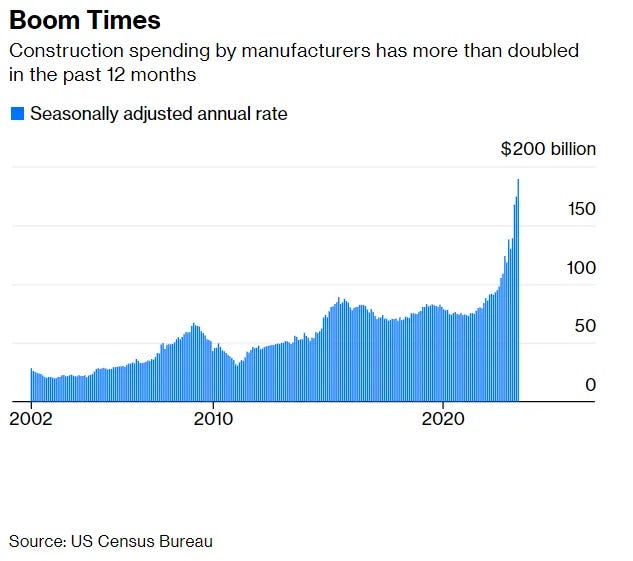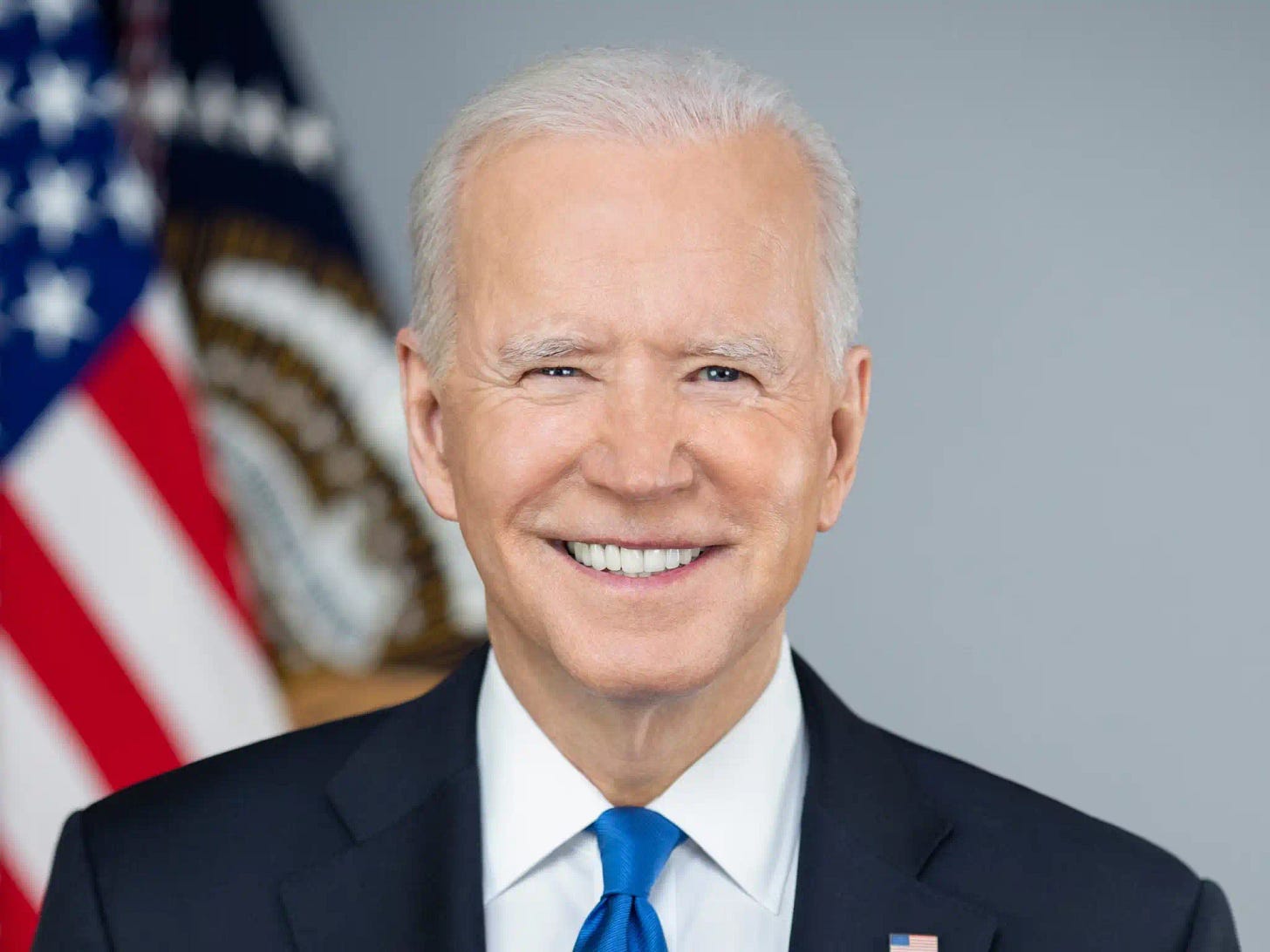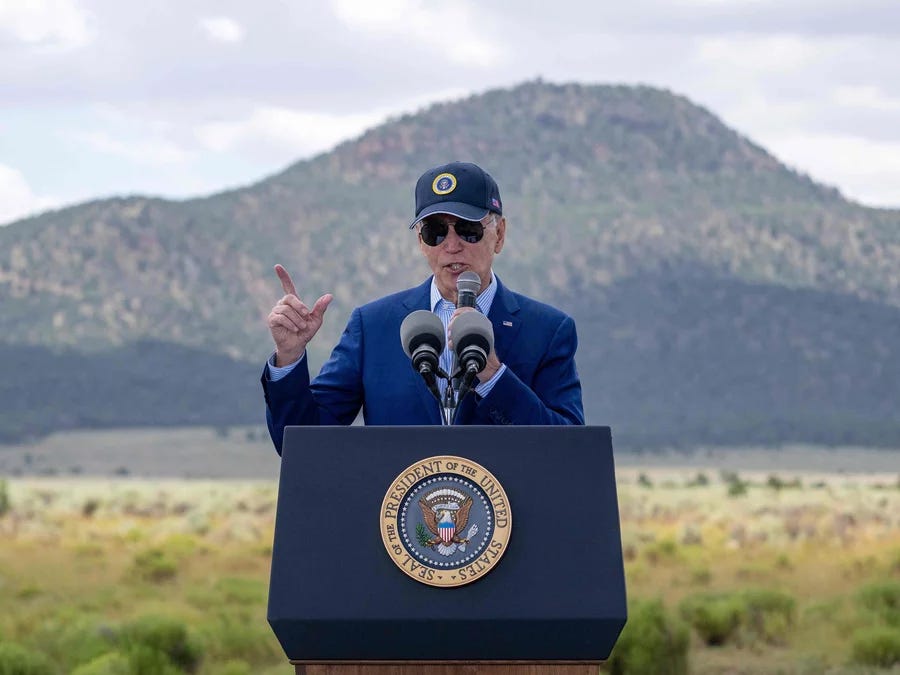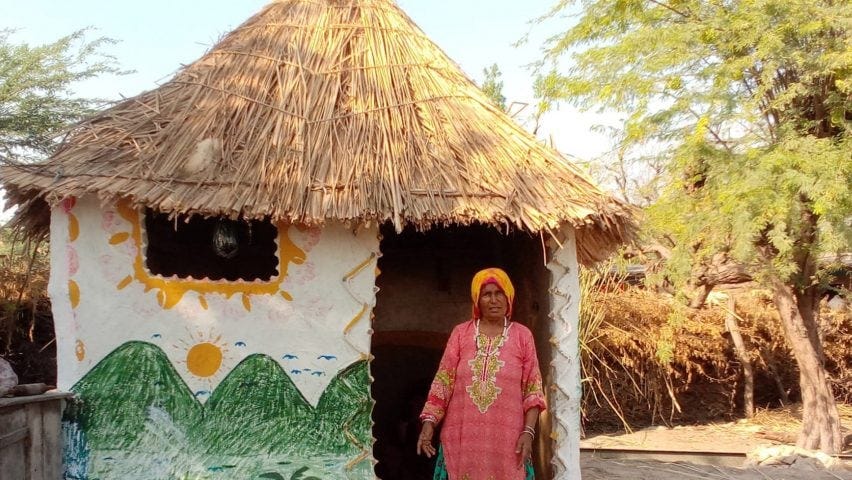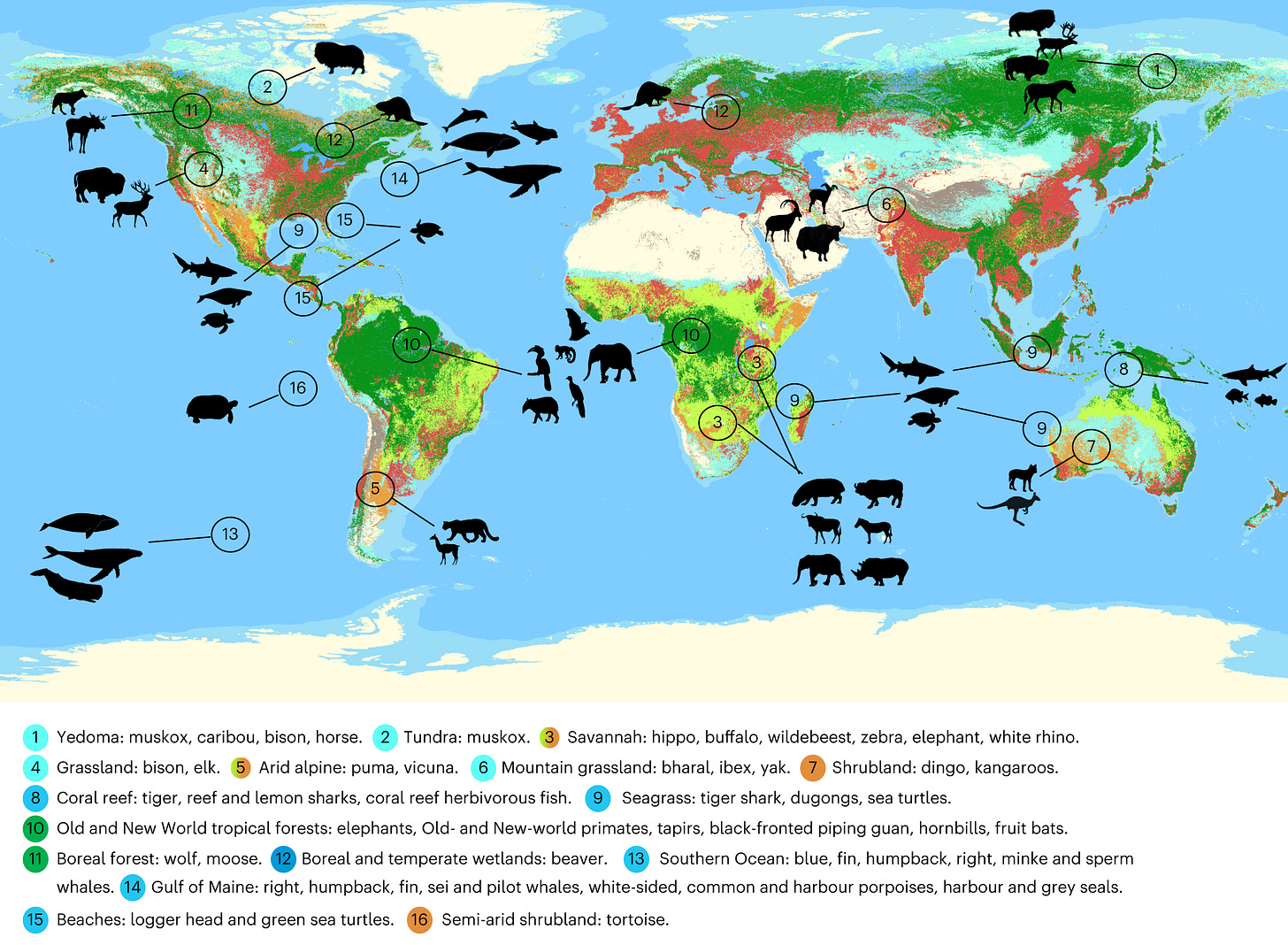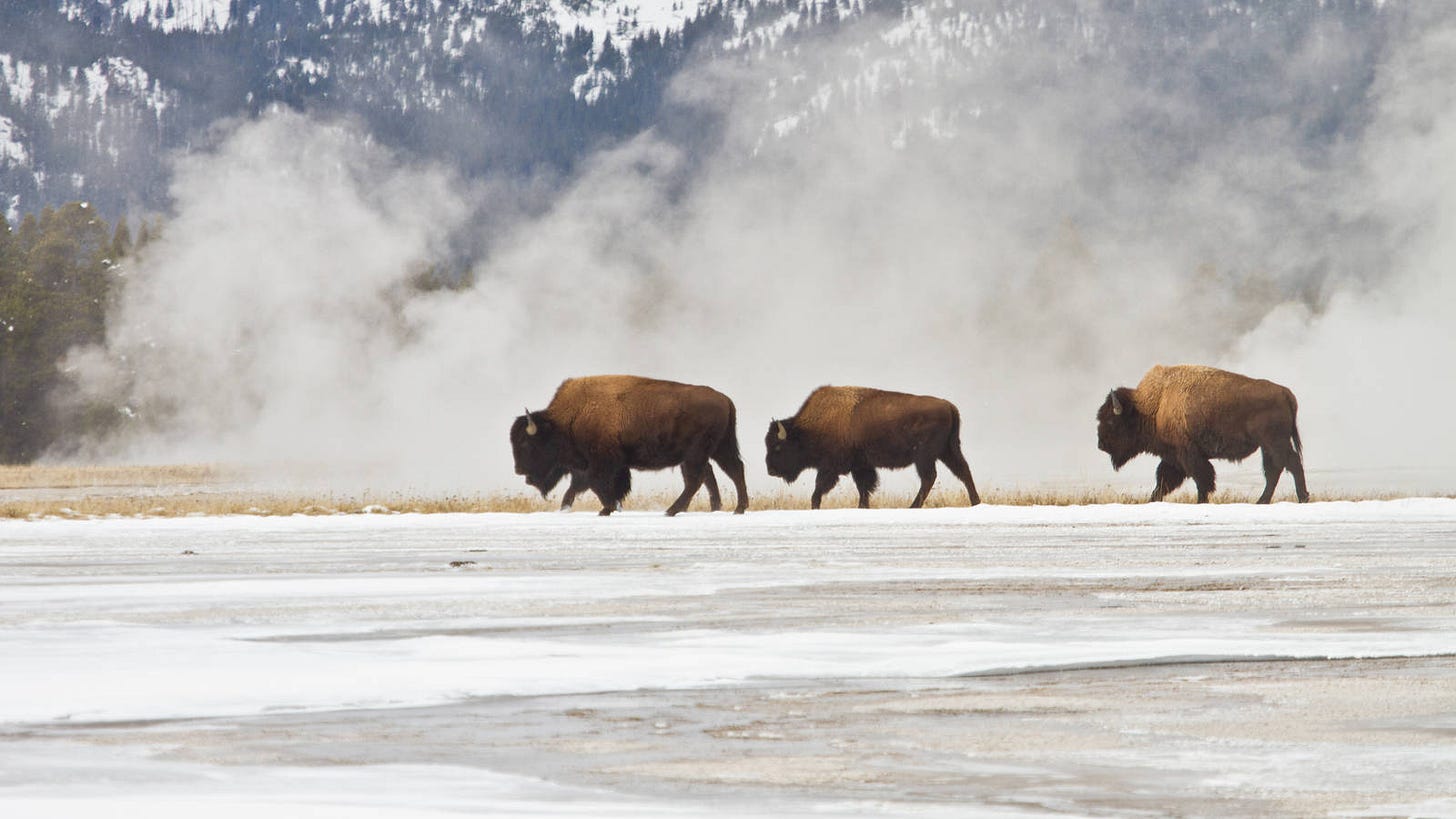2023 In Review
Building on 2022's progress with clean energy, new inventions, rewilding, and more!
2023 was an incredible year for clean energy, climate progress, and human innovation creating a better relationship with our biosphere! Here’s a roundup of some of the biggest trends and developments from the year, as covered by The Weekly Anthropocene
This is our extra-extra-long end of year review, so your email provider will likely cut it short. Make sure to click to see the whole thing if necessary, or see the full article online at sammatey.substack.com!
The Big Picture: Emissions Are Peaking, Renewables are Unstoppable!

In 2023, the International Energy Agency released several blockbuster reports1 containing some incredible news on the rapidly advancing global renewables revolution. This is really worth taking a moment to pay attention to, celebrate, and be inspired by!
Here are some key takeaways and IEA quotes:
Global greenhouse gas emissions are expected to peak before 2025, possibly as soon as this year (2023) and decline thereafter!
Every year, rapidly advancing renewables deployment and national policy actions are adjusting projected future global greenhouse gas emissions in the right direction (see chart above)!
“Renewables are set to contribute 80% of new power capacity to 2030 in the STEPS [stated policy scenario, the path we’re currently on], with solar PV alone accounting for more than half.”
“In 2020, one in 25 cars sold was electric; in 2023, this is now one in 5.”
Under current policies, global fossil fuel use is expected to peak by 2025, and global coal, oil, and gas use are each individually expected to peak before 2030.
“Thanks largely to the Inflation Reduction Act in the United States, we now project that 50% of new US car registrations will be electric in 2030 in the STEPS.”
Global investment in clean energy in 2023 is at about 1.8 trillion USD per year, compared to just 1 trillion for fossil fuels. The IEA expects global clean energy investment to be 2.5 times larger than global fossil fuel investment by 2030.
“More than 500 gigawatts (GW) of renewables generation capacity are set to be added in 2023 – a new record.”
“More than USD 1 billion a day is being spent on solar deployment.”
“Bending the emissions curve onto a path consistent with 1.5 °C remains possible but very difficult…despite the impressive clean energy growth based on today’s policy settings, global emissions would remain high enough to push up global average temperatures by around 2.4°C this century.”
“The transition to clean energy is happening worldwide and it’s unstoppable. It’s not a question of ‘if’, it’s just a matter of ‘how soon’ – and the sooner the better for all of us.”
-International Energy Agency Executive Director Fatih Birol.

As the beautiful graph above depicts1, clean energy technologies are growing faster than 2005-era environmentalists’ wildest dreams. As one IEA report notes, “This progress reflects cost reductions for key clean energy technologies – solar PV, wind, heat pumps and batteries – which fell by close to 80% on a deployment weighted average basis between 2010 and 2022.” Global energy sector emissions are now expected to peak around 2025 and fall to approximately 2015 levels by 2030. Economics is now pushing in the direction of more and more clean energy and lower emissions! This is one of the most underreported stories in the world.
All that has added up to a big shift, in a good direction, of expected global warming. One of the new IEA reports calculates that due to rapid renewables growth, we’re currently on track for 2.4°C of warming above pre-industrial conditions by 2100, and it’s still possible that we could hold warming to as low as 1.5°C by 2100 (the Paris Agreement goal) with extra effort. This is amazing progress! As recently as 2011, the worst-case “RCP 8.5” global warming scenario still seemed plausible, which in the “worst case of the worst case” could have led to warming as high as 4.8°C by 21002. We’re now on a much better path, and we can do better still!
“Ten years ago, the world was on a pathway to warm by up to 5C (that’s 9F) by the end of the century, according to the analysis I led for the last U.S. National Climate Assessment. Today, thanks to policies enacted since the Paris Agreement was signed…current policies will limit warming to 2.7C (5F) and this number could fall even further with more aggressive climate action.
It’s still not enough to avert dangerous levels of change: but as the science says, “every bit of warming matters.” The very real and quantifiable benefits of what we’ve achieved so far encourage us to keep going, and there’s plenty of positive momentum out there.”
-Leading climate scientist Dr. Katharine Hayhoe (on her Substack). Note that she cites 2.7C not 2.4C as expected warming with current policies: renewables’ rapid growth keeps changing that number!
Even as climate change’s impacts ramp up, human civilization is at long last winning the fight to transition to a decarbonized energy system, and this writer would bet on it continuing to accelerate even faster than the IEA expects. It’s taken much longer than it should have, but in 2023, we really started to hit our stride!
AI for Earth
2023 was a big year for AI. In addition to all the market & tech drama, the year saw fascinating new uses of AI for wildlife conservation and ecological monitoring popping up around the world.

First Nations-led fisheries authorities in British Columbia, Canada have partnered with marine scientists to develop and train a world-first deep learning system that automatically counts and identifies 12 fish species (including all five Pacific salmon species) from video footage. (Here’s the study detailing their work). The Heiltsuk Nation has already successfully tested a pilot version of the system at their salmon weir on the Koeye River, and the researchers plan to be working with 10 different First Nations to monitor salmon in real time throughout the migration season by 2025. Amazing work!
In Ecuador, AI tools analyzing and identifying species heard in acoustic monitoring data (formerly a human expert-level task) was found to correlate with recovering forests’ overall biodiversity level. We’re successfully automating measuring the health of a forest from its soundscape.
A global research initiative is using AI to analyze remote sensing data and predict likely hotspots for underground mycorrhizal fungi networks.
In Nepal, researchers are working to use AI and camera traps to recognize and profile individual spotted deer based on their spot patterns.
British scientists have successfully tested, at three sites, a network of AI-controlled cameras and microphones to automatically identify wild animals based on their appearance and sounds, then log and record that data. Biodiversity research has the potential to scale up massively as tech like this becomes more widely used!
The World Wildlife Fund and Google deployed over 600 AI-driven cameras across Australia to monitor wildlife recovery in areas affected by the devastating bushfires of 2019-20. They found heartening signs of recovery for many animals (here are some pictures): detecting more threatened species than expected, recording koala survivors in the Blue Mountains, discovering unrecorded colonies of brush-tailed rock wallabies in lands formerly aflame, and a recovering population of Kangaroo Island dunnarts despite the fires recently burning almost all of their territory. Great news!
Amazon river dolphins, or “botos,” are an endangered species that is notoriously hard to track and study, spending most of their time in hard-to-navigate Amazon Basin waterways and floodplains. Now, a team based out of Brazil’s renowned Mamirauá Institute of Sustainable Development is using AI and a network of underwater sound recorders to gain an unprecedented understanding of these fascinating creatures. The researchers trained an AI system to rapidly determine whether noises heard by the underwater “hydrophones” were dolphin clicks, boat engines, or just rain, eventually identifying dolphin sounds with 95% accuracy. This allowed them to learn about the dolphins’ movement patterns in response to seasonal floods, as well as automatically detect when boats were passing through core dolphin areas.
This is one of many fascinating examples worldwide of automating ecological monitoring with AI. Other ongoing efforts that may or may not pan out include building robots to automate coral restoration planting off Australia and an AI-driven “bear-dar” polar bear early warning system in Churchill, Manitoba. One could hope that we’re seeing the glimmering beginnings of a true “Naturenet,” global 24/7 monitoring of Earth’s ecosystems’ key vital signs!
And here are just a few quick examples of what AI can do for the environment outside the wildlife realm!
Recycling in the US has long been languishing, in large part due to difficulties in sorting waste into different recyclable materials. A startup called Amp Robotics is among the enterprises now trying to solve this with fast-sorting AI-enabled robots. Two of them, “Sorty McSortface” and “Sir Sorts-A-Lot,” are already at work in Colorado’s Boulder County Recycling Center. If this can scale, it could be really helpful, potentially even breathing some life back into the long-cherished hope of a “circular economy.”
In Sweden, the Ekobot uses AI to recognize weeds in fields, then deploys its metal fingers to manually pluck them. It can navigate for 10-12 hours a day on one charge, and can cover 10 hectares a day. In trials, the Ekobot allowed onions to be grown with 70% fewer herbicides. The first onions grown with Ekobot weeding, dubbed “5G onions,” recently became available in Swedish stores, and the Ekobot will soon be rolled out in carrot and beet fields in Sweden as well as other enterprises in Denmark, Norway, and the Netherlands. It should be available across the U.S. and UK by 2030!
22 cities in California are experimenting with AI-powered instant permitting, using software that essentially automates the legal process of approving solar developments. This is great, and hopefully scales nationwide! Outflanking NIMBYism and permitting barriers could be a vital new use for AI.
And perhaps most excitingly long-term, the Lawrence Berkeley National Laboratory is developing an extraordinary automation of the entire process of scientific and technological discovery, already capable of creating novel useful materials 24-7 with no humans in the loop. At the LBNL, an AI is directing robots to conduct experiments to identify new high-functioning materials for battery electrodes, superconductors, and more. Here’s a description of how the autonomous “A-Lab” (pictured) works.
“The AI starts by coming up with a plausible way to synthesize a material, using its understanding of chemistry. It guides robotic arms to select among nearly 200 different powdery starting materials, containing elements such as lithium, nickel, copper, iron, and manganese. After mixing the precursors, another robot parcels out the mix into a set of crucibles, which are loaded into furnaces where they can be mixed with gases such as nitrogen, oxygen, and hydrogen. The AI then determines how long to bake the different mixes, the temperatures, drying times, and so on.
After the baking, a gumball-like dispenser adds a ball bearing to each crucible and shakes it to grind the new substance into a fine powder that’s loaded onto a slide. A robot arm then grabs each sample and slides it into an x-ray machine or other equipment for analysis. Results are fed back into the Materials Project database of materials structures and properties, and if the outcome isn’t what was predicted, the AI setup iterates the reaction conditions and starts anew.”
This writer is excited to see what comes next!
New Inventions
AI is particularly attention-grabbing, but 2023 saw tons of other incredible technological innovations that deserve the spotlight. We really are living in the Roaring 20s! Here are a few highlights:

In 2023, Fervo Energy made grid-scale enhanced geothermal power generation a reality, pulling off a successful commercial-scale test in Nevada in July 2023 and starting drilling in September 2023 for a 400-MW facility in Utah set to be complete by 2028. (Enhanced geothermal systems, or “EGS,” work by essentially making its own underground hot water deposits instead of tapping into existing ones like regular geothermal. EGS projects inject water far enough underground that it heats up, then let that hot water rise back up another drilled well to turn a turbine to produce clean lectricity. This offers a tantalizing vision of a holy-grail energy source: carbon emissions-free power obtainable anywhere in the world 24/7 without even the need for battery storage to ensure reliability). Now, Fervo has connected its Google-funded 3.5-MW Nevada test site to the grid, providing clean electrons for the local utility. Another big step in the dawn of enhanced geothermal! Great work.
Northvolt, a Swedish battery-making start-up backed by Volkswagen, BlackRock, and Goldman Sachs, has invented a sodium-ion battery that uses no lithium, cobalt, or nickel. Critically, this appears to be the first sodium-ion battery to reach the energy storage metric of 160 watt-hours per kilogram, comparable to 180 watt-hours per kilogram for the lithium-ion battery models currently used for grid-scale electricity storage. Northvolt plans to build new factories to make their breakthrough batteries and reach full-scale production by 2030. Lithium prices are very low right now, thanks to strong production in China and Australia, so there might not be that much of an economic incentive to switch to sodium-ion batteries for a while. However, there might well be a strong geopolitical incentive, as China remains a major player in lithium mining and processing.
It’s great that human ingenuity keeps growing the range of battery chemistries we can use in the renewables revolution! The potential is immense.
Two eVTOL startups, Joby and Volocopter, conducted test flights in New York City recently. Joby plans to roll out an air-taxi service providing rapid seven-minute flights linking JFK Airport with Manhattan.
eVTOLs (electric flying taxis, essentially) took the spotlight as an emerging clean transport technology in 2023, with several American companies nearing the commercial stage. Joby and Volocopter both took test flights in New York City this year, and China has given regulatory approval to a pilotless eVTOL model. Joby plans to roll out an air-taxi service providing rapid seven-minute flights linking JFK Airport with Manhattan. Electric flying cars are here, folks!
Michigan is now home to America’s first stretch of road that can charge EVs while driving on it. A quarter-mile stretch of Detroit’s 14th Street is testing startup Electreon’s wireless road charging technology.
Labs around the world are starting to find new ways to use advanced chemistry at extreme temperatures and pressures to finally break down PFAS, the widely used per-and polyfluoroalkyl substances known for possible health risks. “Forever chemicals” no more, hopefully!
Short corn is an emerging climate resilience solution. It’s as simple as it sounds: breeding or genetically engineering corn plants to grow ears of corn on shorter cornstalks, with the same or higher yield but less risk of being blown over in extreme weather. This is not a hypothetical concern: an extreme windstorm in August 2020 destroyed about 16% of Iowa’s corn and soybean crop. These kind of agricultural innovations will help safeguard humanity’s food supply despite climate disruption!
Human civilization’s two shiny new malaria vaccines (RTS,S aka Mosquirix and the newer mRNA-based R21/Matrix-M) are both doing spectacularly!
A new analysis has been released covering the results of a four-year RTS,S rollout that has vaccinated nearly 2 million young children in Ghana, Kenya, and Malawi since 2019. The researchers found that the vaccine reduced deaths in young children that got all three doses by 13% compared to unvaccinated children. And note that that’s not “reduced deaths from malaria by 13%.” The malaria vaccine prevented 13% of all children’s deaths from all causes! This is a great victory. Seventeen more African countries will start rolling out RTS,S doses next year.
“The malaria vaccine has been a game-changer and a breakthrough. We’ve seen mortality go down in under-1 and under-5 children. People didn’t think we could have a vaccine for malaria, and now everyone’s excited.”
-Dr Gordon Okomo, County Director of Health, Homa Bay County, Kenya
Furthermore, the World Health Organization is now officially recommending R21 for the prevention of malaria in children, following the official RTS,S recommendation in 2021. R21 doses will be joining the fight on the ground by mid-2024.
For context on all this, almost half a million children die from malaria each year, mostly in sub-Saharan Africa, and scientists have long worried that climate change will expand malaria’s area of effect. These new malaria vaccines have a good chance at being the most effective life-saving tools in the world over the next decade, blunting the impact of climate change and sparing tens or hundreds of thousands of children from painful, pointless deaths. Great news!
“As a malaria researcher, I used to dream of the day we would have a safe and effective vaccine against malaria. Now we have two.”
-Dr. Tedros Adhanom Ghebreyesus, WHO Director-General.
A new partially wind-powered modern container ship set sail in 2023, part of a rising wave of decarbonizing modern industrial shipping. It’s called the Pyxis Ocean, owned by Mitsubishi, and is voyaging from China to Brazil with the help of prototype “WindWing” solid sails that were designed by the UK’s BAR Technologies, manufactured in Norway by Yara Marine, and added to the ship in Shanghai. They should replace an average of 1.5 tonnes of fuel per WindWing per day, reduce the Pyxis Ocean’s emissions by about 20%, and on new-build ships could reduce emissions by up to 30%! This is big, as industrial-scale shipping is a vital component of the global economy and contributes a full 3% of global greenhouse gas emissions. Great work!
"I do predict by 2025 half the new-build ships will be ordered with wind propulsion.”
-John Cooper, BAR Technologies

The world’s first battery-powered heavy-haul freight train was unveiled in Erie, Pennsylvania on October 31, 2023! Made by Pennsylvania locomotive company Wabtec, it will undergo track tests in America and then be shipped to Australia to work for the Roy Hill iron ore mining company. (It’s hot pink because Roy Hill’s chair is involved in breast cancer-related philanthropy). Wabtec is also currently working on an order for four more electric trains for another Australian mining site.
A non-fossil fuel burning 75-passenger ferry, the Sea Change, is set to launch in San Francisco in 2024, powered by both hydrogen fuel cells and a lithium-ion battery.
The Gila River Indian Community in Arizona is building America’s first solar canal, a normal irrigation canal with a solar canopy over it to generate power while reducing water loss to evaporation. The first phase of the project should be complete in 2025!

Google founder Sergey Brin has received federal clearance to begin outdoor flight testing of his experimental titanium and carbon fiber airship, the Pathfinder 1. At 124 meters long, substantially longer than a jumbo jet, this behemoth is now the largest lighter-than-air airship anywhere in the world since the infamous crashing of the Hindenburg in 1937. (Unlike the Hindenburg, the Pathfinder 1 uses non-flammable helium as its lifting gas instead of hydrogen). A 180-meter Pathfinder 3 is already being built in Ohio, and Brin’s company, LTA Research, plans to develop more airships for use in disaster relief and cargo transport. As Bill McKibben recently wrote, in a decarbonized future, there might be blimps!
Brazil

In January 2023, Lula da Silva took office as President of Brazil, replacing the infamous Jair Bolsonaro, who openly encouraged illegal logging and mining in the Amazon Rainforest and presided over a surge in deforestation. In 2023, Lula took a wide range of legal, regulatory, and administrative actions to stop Amazon deforestation, kicking off a “Brazilian environmental renaissance.”
First off were a wave of executive orders aimed at reversing the degradation of Brazil’s environment and institutions under the Bolsonaro Administration. Among these key actions, Lula annulled a vicious Bolsonaro decree that actively encouraged mining in Indigenous lands and protected areas, restarted a government action plan to fight deforestation, moved the Rural Environmental Registry tracking land ownership from the notoriously pro-deforestation agriculture ministry to the environment ministry, toughened the environmental fine process, and reactivated the Amazon Fund by reinstating its suspended governance structures.
President Lula also officially “demarcated” six territories as Indigenous lands in 2023, which all together cover 621,800 hectares of land (about 2,400 square miles), an area larger than the American state of Rhode Island. According to renowned environmental news site Mongabay, these six territories are the “Arara do Rio Amônia home of the Arara people in Acre state; Uneiuxi home of the Maku Nadёb people in the Amazon state; Avá-Canoeiro home of the Avá-Canoeiro people in Goiás state; Kariri-Xocó home of the Kariri-Xokó in the state of Alagoas; Tremembé da Barra do Mundaú home of the Tremembé people in the state of Ceará; and Rio dos Índios, home of the Kaingang people in the state of Rio Grande do Sul.” They are home to 4,000 Indigenous people, who now have legal ownership of their ancestral territory. This is both a long-awaited victory for oppressed peoples’ land rights, and an affirmation of one of the most effective methods of forest conservation in Brazil. Between 1990 and 2020, lands occupied by Indigenous peoples in Brazil (both formally demarcated and awaiting demarcation) lost just 1% of their forest, compared to 20.6% on privately held lands. Another study found that Indigenous lands in Brazil are some of the last parts of the forest reliably sequestering carbon dioxide, again due to Indigenous peoples’ consistently fighting deforestation.
In 2023, deforestation in the Brazilian Amazon started to decline!
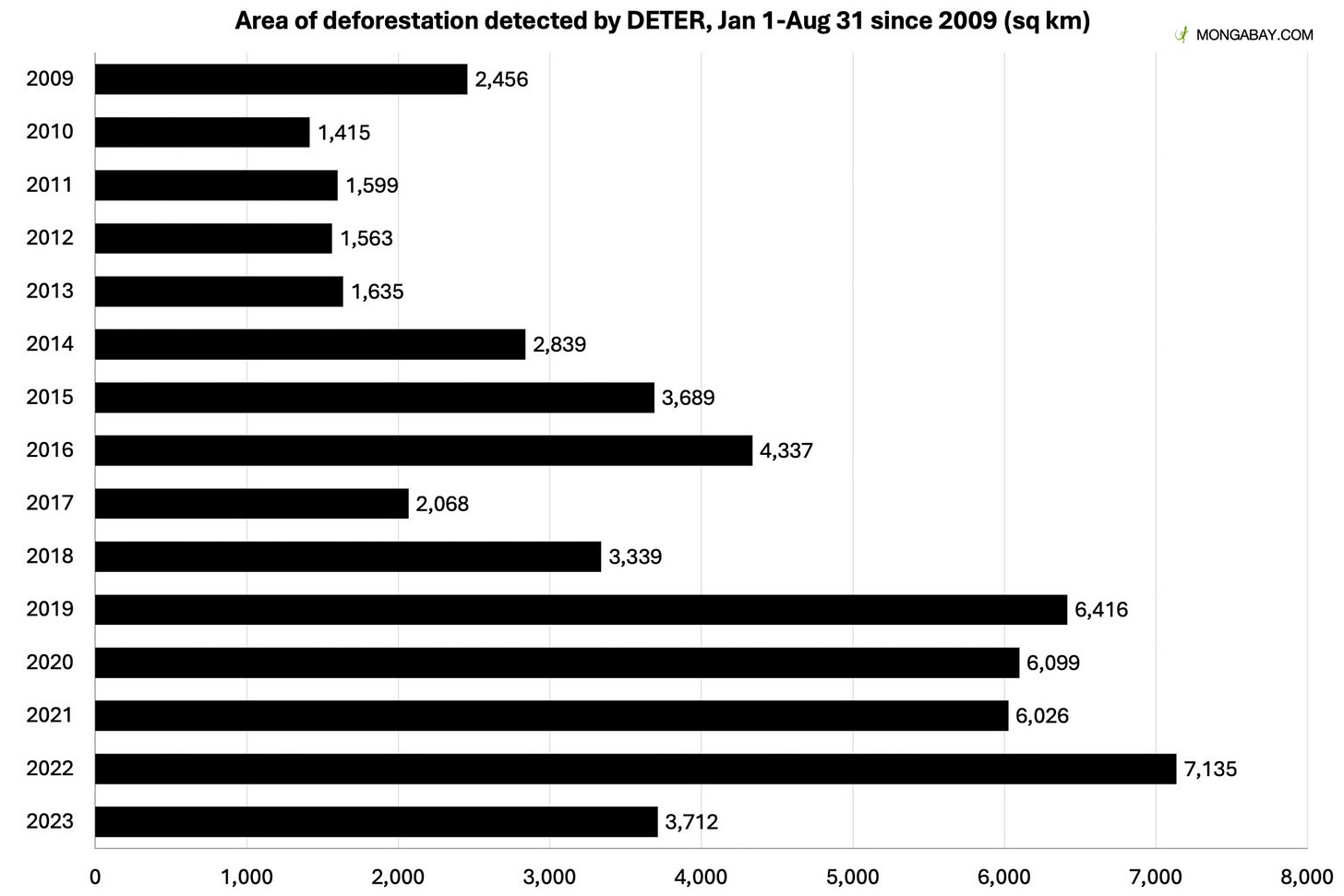
Brazil’s national satellite deforestation alert system reported that only 563 km2 of the Brazilian Amazon was cut down in August 2023, down 66% from August 2022. For January through August 2023, 3,712 km2 of Amazon rainforest were lost. That’s bad, but it’s better than before: a decrease of 48% from the 7,135 km2 lost in January-August 2022 and the lowest deforestation figure since 2018 (the last pre-Bolsonaro year). Enforcing environmental law is good!
Lula also restored Brazil’s 2015 greenhouse gas emissions reduction targets (which were weakened by Bolsonaro), returning Brazil to its previous level of climate action commitment.
Spurred on by commercial pressure from the European Union’s anti-deforestation laws, Brazil’s banking system is instituting new credit rules that will require meatpackers and slaughterhouses to prove that their cattle didn’t come from illegally forested lands. This could be huge!
One of the most shameful episodes of Brazil’s dark years under President Jair Bolsonaro was his encouragement of the arguably-genocidal attacks by thousands of illegal gold miners against the Yanomami indigenous people, which resulted in horrifying mass starvation by 2022 as the illegal mines’ mercury poisoned vital fish-bearing rivers. Newly elected President Lula da Silva sent in federal special forces and several police agencies to expel the illegal miners in February 2023, complemented by an immense healthcare effort.
Now, though conflict is ongoing, substantial progress has been made in protecting the Yanomami. In June 2023, satellite data found zero illegal mining alerts in Yanomami territory for the first time since 2020. By July 2023, Brazilian Minister of Indigenous Peoples2 Sonia Guajajara reported that 82% of the miners had been removed from Yanomami land, while efforts to heal malnourished Yanomami children are already starting to work.
The Brazilian Supreme Court recently ruled against a Bolsonaro-era legal theory that would have stripped legal protections from vast swathes of indigenous lands, opening them up to logging and mining. This is a major bullet dodged!
And a new 2023 study in Science Advances adds weight to the theory that the Amazon’s super-fertile “terra preta” soils (which cover only a few percentage points of the forest but are disproportionately rich in nutrients) were intentionally created by ancient indigenous civilizations. The researchers analyzed soil enriched by modern indigenous peoples’ practices of the soil with fishing waste, ash, and agricultural waste, finding substantial similarities with the ancient soils. They also found that in some ancient sites, the terra preta soils store as much carbon than the aboveground forest biomass! The ancient peoples of Amazonia have left a gift that is already helping us in the fight to stabilize Earth’s climate—and may be even more valuable as an example to follow.
China
China is building truly vast amounts of renewable energy, and the pace is continuing to accelerate. A new analysis has calculated that China is on course to generate 1,200 gigawatts (1,200,000 megawatts) of power from wind and solar alone by 2025-five years earlier than their 2030 goal. (Here’s the full report from Global Energy Monitor). For context, at the end of 2021, the entire United States had just under 1,200 gigawatts of electricity generating capacity, from all sources of energy combined.

Although China is still building more coal plants as well, in fact six times as many new coal plants than the rest of the world combined, it’s possible that much of it may end up not being used, as renewables increasingly predominate and many Chinese coal plants are already loss-making. Massive utility-scale solar and wind farms are under construction in China’s northwestern deserts, rooftop solar is spreading rapidly through China’s cities, and offshore wind projects sprouting along the coasts.
Just one example of what’s happening: at a 400-megawatt offshore wind farm in the waters Fujian Province, the world’s largest wind turbine was installed on June 28, 2023. The single turbine (pictured above) was 146 meters high at the hub, with a 252-meter blade diameter, and generated 16 megawatts all by itself.
Rooftop solar is also growing insanely rapidly in China. Bloomberg reports that China added a whopping 51 gigawatts of small-scale (i.e. rooftop) solar capacity in 2022, meaning they installed more rooftop solar alone than any other country installed rooftop and grid-scale solar and wind combined! Here’s a non-paywalled version of the full article.
This is just insane, in a good way! This reader has been semi-obsessively following clean energy news since the Bush Administration, and has never seen anyone predict that China would build this much solar this fast. For context, the entire United States had less than 1,200 gigawatts of electricity generating capacity at the end of 2021, and added less than 40 gigawatts of all clean energy, not just rooftop solar, in 2022. And that still counts as really impressive progress in the U.S., and will likely rise much further in the upcoming years due to the Inflation Reduction Act! China’s rooftop solar boom is just on another level in terms of speed and reach. The world has never seen anything like it.
Despite the ongoing USA/China geopolitical rivalry and China’s horrific human rights abuses, this counts as good news for democracies too. More Chinese solar and wind means less air pollution and greenhouse gas emissions, benefiting the entire world! And all this clean energy progress is starting to have epoch-making effects in that department: a landmark new analysis has found that China’s carbon dioxide emissions will likely peak this year and start declining in 2024, thanks to an unprecedentedly large and rapid clean energy buildout. (It’s hard to wrap one’s head around just how much clean energy is being built in China these days; for another point of comparison, the installations of new solar, wind, nuclear, and hydro power in China this year alone should generate enough electricity to supply all of France). Yes, despite the concurrent buildout of coal plants: clean energy is being built even faster, and is likely to meet all new electricity demand and start cutting into fossil fuel’s share of existing demand in 2024. This is…a really big deal! Right now is what it looks like when China really starts to go for clean electrons over dirty coal. Great news.
India
In 2023, India became the world’s most populous country with over 1.4 billion people, overtaking China, which is now experiencing population decline. 2023 in general may be remembered as an inflection point in which India became prosperous, powerful, and influential than ever before.
The last few decades have seen incredible leaps in Indians’ quality of life. Extreme poverty has been reduced immensely, with the number of Indians living on (inflation-adjusted) $2.15 a day or less falling from over 420 million people in 1983 to under 140 million in 2019, even while the overall Indian population grew from under 750 million to over 1.3 billion in the same period!
In 1994, about 50% of Indians had access to at least basic electricity (i.e. a lightbulb and basic phone charger, but no appliances), rising to 99% in 2020.
43% of Indians used the Internet in 2020, up from 7.5% in 2010. And as many Indians are English-speaking and India’s internet isn’t firewalled off like China’s, this translates to substantial global influence on a person-to-person level.
And famously, in 2000 over 79% of Indians lacked access to improved sanitation facilities (i.e. they had no latrines or toilets), falling to under 17% in 2020.
India is in the middle of accelerating, exponential renewables growth: their total installed solar capacity rose from 6 gigawatts in 2015 to 63 gigawatts in 2022.
And in India as across the world, renewable energy is dominating the future of the grid: as this writer never tires of repeating, an amazing 92% of new electricity-generating capacity added in India in 2022 was solar and wind!
Reuters has reported that India’s rate of emissions intensity6 fell by an impressive 33% from 2005 to 2019, as renewable energy grew and forest cover increased.
India remains the largest democracy in the world, with new national elections due in 2024.
India is rapidly expanding and deepening its geopolitical partnership with the United States, with a major new India-U.S. defense and industrial agreement in June 2023.
India rapidly lifting its billion-plus population up from poverty is a great victory for humanity, and continuing that progress by adding primarily renewable new energy will be a gift to all of Earth’s biosphere.
United States of America: The Biden Boom
Thanks to Biden Administration leadership, America has made incredible progress in 2023. In particular, there has still been not nearly enough media coverage of the epic, historic victory that is the Inflation Reduction Act (IRA) of August 2022, and its unleashing of an unprecedented American clean energy boom. Here’s a very abridged list of just a few of the major news items from the U.S.A. in 2023
The historic, economy-transforming Inflation Reduction Act was signed into law in August 2022. One year later, it’s outperforming its supporters’ wildest dreams, with consistent federal funding for clean energy sparking an unprecedented economy-reshaping manufacturing boom across America. The map above shows the booming new battery, EV, solar, and wind factory projects announced since the IRA was passed.
“In just 12 short months, Biden’s Inflation Reduction Act has spurred more than 100 new cleantech manufacturing announcements and nearly $80B in private investment.”
-Canary Media
As Bloomberg reports (see chart), construction spending by manufacturers in the United States more than doubled between June 2022 and June 2023, with an associated jobs surge.
Just under $80 billion in investment across nearly 100 new American clean energy manufacturing projects was announced between the IRA signing in August 2022 and the end of May 2023, mostly for solar panel, battery, and EV plants.
Much of this is in a new Eastern “battery belt” region stretching from Michigan to Georgia, revitalizing historic manufacturing communities. Notably, the five key swing states of Georgia, Michigan, Nevada, North Carolina, and Arizona have each received over $1 billion in new EV supply chain investments.
American lithium-ion battery manufacturing is on track to grow tenfold by 2027.
One company, South Korea’s LG, is responsible for quite a lot of the new battery factories in the above map, partnering with American companies including GM in plans to build nearly 280 gigawatt-hours’ worth of battery-making capacity across factories in Georgia, Ohio, Michigan, Tennessee, and Arizona.
Wind turbine manufacturing in the US is making a comeback as well, after a downturn in recent years as many companies moved to countries with lower labor costs.
And displaced coal miners are finding new jobs in clean energy manufacturing, with one battery plant in West Virginia committing to hire UMWA union miners for the vast majority of jobs.
A new report from Dartmouth, Princeton, and the BlueGreen Alliance has calculated that thanks to the IRA (specifically the 45X MPTC tax credit for clean manufacturing), it will shortly be cheaper for American energy projects to use American-made solar and wind components than imported solar and wind components. Once the huge wave of new solar panel factories currently in the pipeline are built, they estimate that completely US-made solar panels will be 30% cheaper than imported solar panels.
And even before the IRA, clean energy in the USA was on a roll. The US Energy Information Administration (EIA) calculates that 84% of new electricity-producing capacity set to come online in the United States in 2023 will be from clean energy, with solar, battery storage, wind, and a tiny bit of nuclear all contributing carbon-free power! That’s up from 78% clean energy in new power capacity built in 2022.
This only counts the projects that the EIA expects will come online and start generating electricity this year. There are lots and lots more renewables projects in the pipeline (in fact, enough proposals to replace all of America’s current electricity generating capacity!), but the ones listed for 2023 are the ones that have made it through the labyrinth of grid interconnection problems, permitting issues, and construction supply chain woes to be confidently listed as nearing completion.
Keep in mind as well that these projects set to finish in 2023 had all made it through major investment decisions before the Inflation Reduction Act was passed in August 2022. Future renewables projects will be substantially cheaper and more financially attractive thanks to new federal funding.
A analysis from the National Renewable Energy Laboratory forecasts that the Bipartisan Infrastructure Law of 2021 (BIL) and the Inflation Reduction Act of 2022 (IRA) are set to deliver immense, far-reaching shifts in the American power sector1, boosting renewables and reducing emissions and health risks much more than the previously expected pathway.
Here’s the full report, and a Department of Energy fact sheet with an awesome summary graphic. Key stats:
Their “mid-case scenario” prediction is that the US grid will have about 81% carbon-free electricity in 2030 (up from 41% in 2022, including solar, wind, hydro, and nuclear). This could be much as “best case” 90% clean electricity by 2030 if technology costs drop faster than expected, or a still-respectable “worst case” 71% clean electricity by 2030 if grid interconnection issues take a toll. Before these bills passed, the NREL expected about 52% clean electricity by 2030.
In their mid-case scenario, the NREL also expects power sector carbon dioxide emissions to decline by 84% below 2005 levels by 2030!
And the replacement of fossil fuels will bring substantial health benefits as well due to reduced air pollution: the NREL expects the IRA and BIL to save 11,000-18,000 lives by 2030!
Since this writer was a small child, rafts of books and reams of policy papers have been produced bemoaning the decline of American manufacturing, and the need to build it up again to help decarbonize the economy and power a clean energy future. And now, seemingly unnoticed by the general public, we’re just going ahead and doing it. The Biden Administration’s deft political leadership to get the IRA passed (and the BIL before it) has unleashed American ingenuity and entrepreneurship in the service of decarbonizing our economy and finally replacing the fossil fuel industry, the root cause of worst public health and ecological threats of our time. In 2023, the Inflation Reduction Act and the Biden Boom in clean energy made this writer proud to be an American.
And the Biden Administration is doing tons of other awesome stuff as well, making progress on other issues from lead pollution to methane emissions to permitting backlogs as well! Here are a few more of the many new sparks of hope from America:
The Biden Administration recently announced $40.8 million in Bipartisan Infrastructure Law funding for centers to train students and workers in clean energy job skills…
…and $169 million in Defense Production Act funds2 for nine projects to accelerate domestic heat pump manufacturing…
…and $3.5 billion (i.e. 350,000 million) in BIL funding to support domestic battery manufacturing…
…and a whole suite of adaptation funding measures, including $300 million for flood resilience projects, $100 million for drought resilience projects, and $3.9 billion for grid modernization!
These kind of steady, sensible investments just keep plugging away at solving wicked problems like climate change and air pollution step by step. They’re barely reported on, but they’re really excellent!
42,000 people have signed up so far for the Biden Administration’s pioneering American Climate Corps (announced in September 2023) which will train members for jobs in climate action fields from wildfire prevention to wind turbine installation. The first cohort will select 20,000 applicants, with more likely to follow. As the similar 1930s CCC, 1960s Peace Corps, and 1990s AmeriCorps created lasting legacies of motivated and experienced people devoted to work on vital issues, the 2020s ACC looks set to pay dividends for decades to come!
The Department of Energy published a formal proposal to grant categorical exclusions from the National Environmental Policy Act (NEPA) for certain solar, transmission line, and energy storage projects on federal land. This is really esoteric, but also really important, since renewables opponents often use NEPA’s lengthy environmental review processes to hijack and slow-walk vital clean energy development. Currently, lots of fossil fuel projects get categorical exclusions from NEPA while renewables projects often don’t, even though they’re really clearly better for the world. The new DOE proposal would level the playing field, and help remove one of the remaining barriers slowing down America’s great clean energy boom!
Nigeria
In May 2023, newly elected Nigerian President Bola Tinubu announced the end of the country’s longstanding fuel subsidy, which had been extremely costly, contributed to Nigeria’s endemic oil-related corruption, and incentivized widespread use of low-quality highly polluting fuel-burning generators for electricity. BloombergNEF, an energy research service, forecasts that Nigerians are now likely to turn to solar power en masse to provide electricity. This could help speed the launch of plentiful decarbonized electricity in Africa’s most populous country!
South Africa
As its increasingly dysfunctional coal-dependent national grid experiences rolling blackouts, South Africa is responding with an unprecedentedly fast solar boom, as citizens seek to ensure a reliable source of electricity. Rooftop solar capacity in South Africa has increased by an unbelievable 349% in just over a year, from 983 megawatts in March 2022 to 4,412 megawatts in June 2023. South Africa also imported five times as many batteries in Q1 2023 as in the entire year of 2022, as people look for reliable storage for their shiny new solar panels. At this rate, RMB Morgan Stanley projects that the increasingly solar-powered South African private sector may generate more electricity than the national grid by 2025!
Pakistan
In 2022, Pakistan was devastated by titanic floods, with one-third of the entire country underwater at one point in late August and over 33 million people displaced. Now, the Heritage Foundation of Pakistan, founded by star architect Yasmeen Lari, reports that they have built 333,000 flood-resilient homes for people displaced by the 2022 floods, with a goal of building 1 million by 2024. To ensure that the process is scalable with local resources, the homes are built with clay, lime, and earth supported by bamboo frames, for a total cost of about $170. Residents often add their own decorations on the outsides. Early “pilot” homes built using this process had an excellent track record during the 2022 floods, in some cases becoming the only remaining inhabitable structures in entire villages. This is an awesome example of community-led climate adaptation; despite dire circumstances, multitudes of people are striving to build a more resilient future!
Ecuador

On August 20th, 2023, Ecuador held unusual snap presidential and legislative elections. In a concurrent referendum, a strong majority of Ecuadorean voters chose to ban oil drilling in Yasuní National Park, a question put on the ballot after years of legal action by the park’s indigenous inhabitants. Yasuní is a contender for the single most biologically diverse place on Earth, an over 9,990 km2 swathe of Amazon rainforest (that’s an area larger than Delaware) home to over 200 species of mammals, 596 species of birds, 120 reptile species, almost 500 fish species, 1,130 known species of trees, and at least 100,000 insect species. It’s also home to the Tagaeri and Taromenane peoples, two indigenous nations living in “voluntary isolation” from modern society, as well as many other non-isolated indigenous communities. The referendum result will shut down the 230 oil wells currently operating on the eastern edge of the park (they have one year to withdraw), and block any further expansion.
This newsletter often urges environmentalists to support resource extraction projects when needed to stop climate change (e.g. lithium mining) and embrace building new things more generally, but this case is a perfect example of the ongoing need for traditional “oppositional” environmentalism where appropriate. Drilling for climate change-worsening oil in a planetary jewel like Yasuní is a clear-cut Bad Idea. Stopping it is great news! Bravo to the people of Ecuador.
“A day we will remember as the day the planet started to win, and corrupt politicians and oil companies lost.”
-Nemonte Nenquimo of the Waorani people
Yemen
One of the biggest environmental victories of 2023 got very little attention because it was a dog that didn’t bark: we avoided a giant oil spill disaster in the Red Sea.
On July 25, 2023, after years of patient diplomatic and technical work, a United Nations-led international team began siphoning the oil out of the decaying FSO Safer oil tanker into a large UN-owned oil tanker renamed the Yemen. The historic mission to prevent an ecological catastrophe in the Red Sea was completed safely in August 2023, with 1.1 million barrels of oil successfully transferred. Yemen’s warring factions will now begin (likely quite lengthy) negotiations on selling the oil and splitting the revenue. But the key point is: catastrophe has been avoided! As longtime readers of this newsletter will know, the FSO Safer is an oil tanker abandoned in 2015 due to the Yemeni Civil War, and decaying since then in dangerous rebel-held waters. Containing four times as much oil as was spilled in the infamous Exxon Valdez disaster of 1989, it was essentially a “ticking time bomb” threatening global commerce, local drinking water and food security, and rare heat-resistant coral reefs in the area. (Check out this article for a more in-depth breakdown). Avoided disasters don’t tend to be remembered, but this one should be-it’s a win for all of humanity!
“A remarkable global coalition came together under the UN umbrella to prevent the worst-case scenario of a catastrophic oil spill in the Red Sea.”
-David Gressly, UN Resident and Humanitarian Coordinator for Yemen
The Weekly Anthropocene wants to take a moment, as an inhabitant of Earth, to deeply thank everyone involved in this project. They’ve basically defused a giant ship-sized bomb threatening global commerce, the Red Sea’s unique coral reefs, and the survival of millions of people. In the middle of rebel-held waters.
Reading the news and press releases from around the time of the operation gives a sense of the audacity of what was successfully attempted here, and the bravery of those doing it. To quote from a Grist article: “The Safer could, with no notice whatsoever, crack like a walnut or erupt at the slightest spark” and “Outside experts note that either vessel would be within range of Houthi artillery or drones. U.N. officials say they have no choice but to trust everyone involved not to target it.” And “It’s also suspected that the waters off Yemen have been mined during the conflict.”
And now…it worked! They pulled it off! How is this victory not bigger news?!
In any case: good job, human civilization. In the Red Sea in 2023, the world got its act together and coordinated an expensive, difficult and dangerous operation, working for the common good of protecting biodiversity, commerce, and human well-being from an avoidable, foreseeable threat. Great news!
Rewilding is Epic
A landmark new 2023 paper in Nature Climate Change (here’s a free access link, with map), “Trophic rewilding can expand natural climate solutions,” makes the case that restoring large wild animal populations would substantially help in the fight against climate change. Large animals tend to increase landscapes and seascapes’ carbon sequestration capacity in a multitude of ways: encouraging plant growth through mechanisms like seed dispersal, grazing animals preventing wildfires by maintaining a healthy plant density, and a multitude of species fertilizing the land or the sea with their feces to produce more plant life. (Whales and ocean-going fish in particular appear to be responsible for fertilizing vast amounts of carbon-sequestering phytoplankton).
The researchers calculated that if key major animal populations around the world were protected and revived, it would sequester 6.4 billion tons of CO2 per year-about a sixth of global energy sector emissions in 2021. One proven example of this is the Serengeti, which researchers have found now sequesters 4.4 million1 more tons of CO2 per year than when wildebeest populations were at their lowest in the 20th century. Notably for this writer’s home region of New England, the marine mammals of the Gulf of Maine are highlighted as of the 16 hotspots where previous carbon cycle research has found “high potential to expand natural climate solutions through trophic rewilding.” This is a key linkage between the two major environmental issues of climate change and biodiversity conservation, and is a valuable theme to highlight for rewilding and climate projects everywhere!
And there are a lot of awesome rewilding and nature restoration projects going on around the world. As with Biden Administration accomplishments, there are way too many to include even in an extra-long article (check out pretty much any issue of the weekly newsletter for a sample) but here are just a few highlights!
The Caribbean island nation of Dominica has announced the designation of the world’s first sperm whale reserve, covering 788 km2 of ocean with new restrictions on vessel traffic to prevent collisions. That’s a relatively small area (almost exactly the same size as New York City), but it’s a crucial feeding and calf-nursing site for the local “Eastern Caribbean Clan” sperm whale population, so protecting it has outsized impact. This is excellent for many reasons. Sperm whales are highly intelligent and social animals (with the largest brains in the world!) that deserve safe havens in their own right, and they also, like other cetaceans, play a surprisingly large role in fighting climate change by fertilizing phytoplankton with their feces. Great news!
For the second time in 2023, a Sumatran rhino calf has been born to the captive breeding program at Way Kambas National Park, Sumatra, Indonesia. The male calf, whose brith was announced on November 25, is the first child of new rhino mom Delilah, who became the first female Sumatran rhino born in captivity to give birth herself.
Sea turtles had a record nesting year across the state of Florida, with over 212,000 sea turtle nests across the state reported 2023, up from 151,000 in 2022. Nest numbers have grown particularly fast in Florida’s 72-mile “Space Coast” stretch of beach near Cape Canaveral, which has seen over 52,500 in 2023 so far: 31,893 green sea turtle nests, 20,545 loggerhead sea turtle nests, 61 leatherback sea turtle nests, and 3 Kemp’s ridley sea turtle nests. Some parts of summer 2023 saw over 300 new nests made per night! The Archie Carr National Wildlife Refuge (part of the Space Coast) saw 13,683 green sea turtle nests by July 21, 2023, up from the 4,638 nests seen in the refuge by that time in 2022 and just 5 to 10 nests per year in the 1980s. Decades of conservation efforts are paying off! As climate change warms and weirds the world’s oceans, it’s good to see that sea turtles finally have safe strongholds in which to breed. Great news.
For decades, Colombia was torn by a civil war between the central government and the FARC rebel group. The fighting finally died down with a U.S.-brokered peace agreement in 2016, allowing thousands of ex-FARC fighters to reintegrate into Colombian society. Now, many of them are turning their skills to ecosystem restoration. The Comuccom ecosystem restoration cooperative near the Ecuadorean border is a particular highlight, home to 24 ex-FARC members and their families, 250,000 seedlings from 50 Amazonian tree species (some endangered) and 65 hives of Melipona stingless bees. Comuccom plans to plant 1 million native trees by 2031 to help resist deforestation in the Colombian Amazon and provide habitat corridors for species ranging from jaguars to hummingbirds.
In France, there were only five brown bears left (with just one female) in the Pyrenees Mountains by 1991, but the tide began to turn when two new females were reintroduced from Slovenia in 1996. Now, there are 76 brown bears spread across the mountain range, and a local civic group called Pays de l’Ours (Land of the Bear) is monitoring the population and educating local humans on living alongside bears.Yet another awesome chapter in the epic saga of Europe’s great Anthropocene rewilding!
For years, an offbeat entrepreneur accumulated a massive herd of 2,000 southern white rhinos (that’s possibly as much as 15% of the entire species!) at his “Platinum” ranch in the North West province South Africa, hoping to sell vast amounts of (nonlethally trimmed, regrowable) rhino horn in the expectation that the rhino horn trade would soon be re-legalized. This didn’t happen, the owners lost money, and they put the rhinos up for auction in April 2023, initially receiving no bids. Fortunately, we got pretty much the best possible outcome from this strange situation: in September 2023, renowned NGO African Parks reached a deal to acquire the ranch and all the rhinos, announcing that they would fund continued security and support staff while developing a plan to rewild all the rhinos into well-secured parks across Africa over the next ten years. African Parks is likely the single most reputable, successful, and organizationally robust conservation presence in Africa (or perhaps the world) at the moment, managing 22 national parks for 12 different African countries and routinely pulling off complex, large-scale translocation operations, once famously trucking five hundred elephants across Malawi. Very few institutions in the world could even handle two thousand rhinos, and even fewer could credibly plan to rewild them, but African Parks can. Great news!
As reported in March 2023, the Biden Administration’s Interior Department will be using $25 million in Inflation Reduction Act funds to boost bison conservation across America, managed by a new Bison Working Group and Bison Management Apprenticeship program. The funds will be used to establish new bison herds, support prescribed-fire efforts to maintain grassland ecosystems, and support the transfer of American bison to Native American tribal lands.
This is an extraordinary culmination to a historic decades-long reversal in American bison policy, from genocidal slaughter to strong and moral conservation efforts. In the mid-1800s, the US government killed as many bison as possible with the express intent of depriving Plains Native Americans of their livelihoods. Now, under the Biden Administration and the first Native American Interior Secretary, the United States is finally working to give bison back to its Native American citizens!
“The rapid disappearance of the game [bison] from the former hunting-grounds must operate largely in favor of our efforts to confine the Indians to smaller areas, and compel them to abandon their nomadic customs.”
-Secretary of the Interior Columbus Delano, a white man, 1872
“While the overall recovery of bison over the last 130 years is a conservation success story, significant work remains to…provide for the return of bison to Tribally owned and ancestral lands. New historic funding from the Inflation Reduction Act will help support the Department’s efforts to restore this iconic species and integrate Indigenous Knowledge into our shared stewardship goals.”
-Secretary of the Interior Deb Haaland, a Native American woman, 2023
The times, they have a-changed…very much for the better!
Whew! That’s a wrap, people. And despite the extra length, it’s nowhere close to all the awesome work that people have done in 2023! Humanity is really starting to step up to build a better Anthropocene. Let’s keep going, further and faster!
The Weekly Anthropocene is trying to introduce additional paid subscriber articles-there are so many epic stories I want to write about in 2024! If you buy (or gift someone!) a paid subscription, you’ll be making this tentative business model sustainable, plus getting access to exclusive The Weekly Anthropocene articles in 2024!
Notably:
The World Energy Outlook 2023 report, here’s the executive summary, and
the Net Zero Roadmap report: check out the full report here, and here’s the PDF):),










